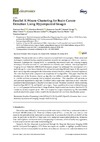Identificador persistente para citar o vincular este elemento:
https://accedacris.ulpgc.es/jspui/handle/10553/43589
| Título: | Parallel K-means clustering for brain cancer detection using hyperspectral images | Autores/as: | Torti, Emanuele Florimbi, Giordana Castelli, Francesca Ortega, Samuel Fabelo, Himar Callicó, Gustavo Marrero Marrero-Martin, Margarita Leporati, Francesco |
Clasificación UNESCO: | 3307 Tecnología electrónica | Palabras clave: | Algorithm Graphics Processing Units (Gpus) Cuda Openmp Opencl, et al. |
Fecha de publicación: | 2018 | Publicación seriada: | Electronics (Switzerland) | Resumen: | The precise delineation of brain cancer is a crucial task during surgery. There are several techniques employed during surgical procedures to guide neurosurgeons in the tumor resection. However, hyperspectral imaging (HSI) is a promising non-invasive and non-ionizing imaging technique that could improve and complement the currently used methods. The HypErspectraL Imaging Cancer Detection (HELICoiD) European project has addressed the development of a methodology for tumor tissue detection and delineation exploiting HSI techniques. In this approach, the K-means algorithm emerged in the delimitation of tumor borders, which is of crucial importance. The main drawback is the computational complexity of this algorithm. This paper describes the development of the K-means clustering algorithm on different parallel architectures, in order to provide real-time processing during surgical procedures. This algorithm will generate an unsupervised segmentation map that, combined with a supervised classification map, will offer guidance to the neurosurgeon during the tumor resection task. We present parallel K-means clustering based on OpenMP, CUDA and OpenCL paradigms. These algorithms have been validated through an in-vivo hyperspectral human brain image database. Experimental results show that the CUDA version can achieve a speed-up of ~<inline-formula> <math display="inline"> <semantics> <mrow> <mn>150</mn> <mo>×</mo> </mrow> </semantics> </math> </inline-formula> with respect to a sequential processing. The remarkable result obtained in this paper makes possible the development of a real-time classification system. | URI: | https://accedacris.ulpgc.es/handle/10553/43589 | DOI: | 10.3390/electronics7110283 | Fuente: | Electronics (Switzerland) [2079-9292],v. 7 (283) |
| Colección: | Artículos |
Citas SCOPUSTM
37
actualizado el 08-jun-2025
Citas de WEB OF SCIENCETM
Citations
28
actualizado el 08-jun-2025
Visitas
74
actualizado el 11-ene-2026
Descargas
59
actualizado el 11-ene-2026
Google ScholarTM
Verifica
Altmetric
Comparte
Exporta metadatos
Los elementos en ULPGC accedaCRIS están protegidos por derechos de autor con todos los derechos reservados, a menos que se indique lo contrario.
